Bainite Transformation-Kinetics-Microstructure Characterization of Austempered 4140 Steel
Abstract
1. Introduction
2. Background
2.1. Bainite Morphology
2.2. Bainite Transformation Kinetics
- n = 1, rod-like shape [20];
- n = 2, disk-like shape, linear growth [21];
- n = 1–2.3, interface controlled [22];
- n = 3.5, parabolic cylinder shape at constant rate [23];
- n = 4, with constant nucleation rate, equates to tri-dimensional linear growth [21].
2.3. Chemical Composition Effect on Kinetics
2.4. Bainite Transformation Activation Energy
2.5. Literature Review Summary
- Nucleation and nucleation rate of bainitic ferrite plates;
- Nucleation sites, at austenite/martensite grain boundaries or at ferrite plate sub units;
- Nucleation sites, at the bainite/austenite interface/internal defect or dislocation;
- Nucleation surface availability;
- Austenite grain size and lattice parameters;
- Austenite stored energy, flow stress and transformation plasticity [42];
- Austenite film entrapment;
- Dislocation density in austenite [40];
- Chemical free energy exchange in austenite/bainite ferrite plate [40];
- Isothermal temperatures;
- Chemical/alloying elements, chemical compositions;
- Carbon content, average or local conditions;
- Carbon diffusion or redistribution rate in bainitic ferrite plate;
- Carbon diffusion or redistribution rate in parent austenite;
- Bainite and austenite boundary local conditions;
- Chemical segregation in austenite [35];
- Bainitic ferrite plates growth rate;
- Cementite/carbide precipitation conditions;
- Pre-existing martensite;
- Soft and hard impingement in the austenite;
- Incomplete bainite reaction phenomenon [43].
3. Experimental Design and Procedures
4. Results and Analysis
4.1. Kinetics Calculation Based on Hardness Measurements
- x(t): Bainite volume fraction at time t;
- H(0): Initial hardness achieved of an isothermal experiment;
- H(f): Final hardness achieved of an isothermal experiment;
- H(t): Hardness at bainite reaction time t.
4.2. 4140 Bainitic Microstructures and Morphology
4.3. Activation Energy of Bainite Transformation
4.3.1. Activation Energy Calculation
- Q: Bainite transformation activation energy [J/mol];
- A: Bainite transformation reaction frequency factor [1/s];
- R: General gas constant 8.31 [J/mol·K];
- T: Isothermal temperature at which bainite is transformed [K].
4.3.2. Bainite Reaction Activation Energy Calculation Based on Reaction Rate 1/t50
4.3.3. Bainite Reaction Activation Energy Calculation Based on K
4.3.4. Comparison of 1/t50 and K Based Activation Energy Calculation Results
5. Discussion and Conclusions
- Bainite transformation kinetics fits the conventional JMKA model. Kinetically there is a clear separation between the four bainite phases matrices. The Avrami constant “n” is around n = 1 for upper bainite, n = 1.7 for mixed upper and lower bainite, n = 1.8 for lower bainite, and n = 2.2 for mixed lower bainite and martensite. The n values have a linear relation with the isothermal holding temperature. The n value is between 1 and 2.3, which indicates the reaction is austenite and bainite interface controlled [14]. The kinetic curve shapes changed from reverse exponential to typical sigmund as undercooling increases in the experiments.
- Bainitic ferrite morphology in experiments was revealed; both upper bainite and lower bainite ferrite plates grew to variable lengths, yet both half-grown bainite sheaves had the same width of 0.64 μm. The full-grown upper bainite was coarse and the sheaves were 1.9 μm in width, and full-grown lower bainite sheaves were slim and are 1.2 μm in width. Both have the typical lath-like appearance under LM. The bainite sheaves in 4140 steel have a width direction growth preference, possibly because its austenite grains are relative small in size or the soft impingement effect. The physical model of this widthwise growth needs further study. Other than the carbide precipitations difference, upper and lower bainite had the same transformation characteristics. Upper bainite and lower bainite mixtures, as well as lower bainite and martensite mixtures, were also observed; their mechanical properties need further exploration.
- Bainite reaction rate can be defined either with the reciprocal of the percentage reaction time (usually the time at 50% reaction) or the rate constant K fitted in the JMKA model. Once the rate was determined, the transformation activation energy can be calculated with the Arrhenius concept using linear regression. For 4140 steel, bainite activation energy was calculated using both methods. Results show that the K based method is more accurate and thus is preferred. The overall activation energy for the entirety of bainite formed, which is the average of the four bainite or mixed bainite phases, is 136 kJ/mol. This matches the carbon diffusion activation energy in austenite. The lower bainite activation energy is 50 kJ/mol, which is lower than the iron diffusion activation energy in both austenite (285 kJ/mol) and in ferrite (259 kJ/mol); this is consistent with the displacive mechanism of bainite transformation, since the activation energy of bainite is much lower than required by a diffusional mechanism. Bainite transformation cannot be carried out by diffusion alone.
Author Contributions
Funding
Acknowledgments
Conflicts of Interest
References
- Bhadeshia, H.K.D.H. Bainite in Steel, 2nd ed.; Institute of Materials: London, UK, 1992. [Google Scholar]
- Davenport, E.S.; Bain, E.S. Transformation of austenite at constant subcritical temperature. Trans. Am. Inst. Min. Metall. Eng. 1930, 90, 117–154. [Google Scholar]
- Gibbs, J.W. A method of geometrical representation of the thermodynamic properties of substances by means of surfaces. transactions of the connecticut academy of arts and sciences 2. Trans. Connecticut Acad. Arts Sci. 1873, 2, 382–404. [Google Scholar]
- Bhadeshia, H.K.D.H.; Edmonds, D.V. The mechanism of bainite formation in steel. Acta Metall. 1980, 28, 1265–1273. [Google Scholar] [CrossRef]
- Liu, Z.; Ågren, J. On the transition from local equilibrium to para equilibrium during the growth of ferrite in Fe-Mn-C austenite. Acta Metall. 1989, 37, 3157–3163. [Google Scholar]
- Avrami, M. Kinetics of phase change. I. General theory. J. Chem. Phys. 1939, 7, 1103–1132. [Google Scholar] [CrossRef]
- Arrhenius, S.A. Uber die Dissociationswarme und den Einfluss der temperature auf den Dissociationsgrad der Elektrolyte. Z. Phys. Chem. 1889, 4, 96–116. [Google Scholar] [CrossRef]
- Bhadeshia, H.K.D.H. Atomic mechanism of the bainite transformation. HTM J. Heat Treatm. Mat. 2017, 6, 340–345. [Google Scholar] [CrossRef]
- Caballero, F.G.; Roelofs, H.; Hasler, S.; Capdevila, C.; Chao, J.; Cornide, J.; Garcia-Mateo, C. Influence of bainite morphology on impact toughness of continuously cooled cementite free bainitic steels. Mater. Sci. Technol. 2012, 28, 95–102. [Google Scholar] [CrossRef]
- Matas, S.J.; Hehemann, R.H. The structure of bainite in hypoeutectoid steel. Trans. Metall. Soc. AIME 1961, 221, 179–185. [Google Scholar]
- Hehemann, R.F. Phase Transformation; ASM: Metals Park, OH, USA, 1970; pp. 397–432. [Google Scholar]
- Jung, Y.C.; Ohmori, Y.; Nakai, K.; Ohtsubo, H. Bainite transformation in a silicon steel. ISIJ Int. 1997, 37, 789–806. [Google Scholar] [CrossRef]
- Goldstein, H.; Aronson, H.I. Overall reaction kinetics and morphology of austenite decomposition between nose and Ms of a Hypereutectoid Fe-C-Cr alloy. Metall. Mater. Trans. A 1990, 22, 1465–1478. [Google Scholar] [CrossRef]
- Bhadeshia, H.K.D.H. The lower bainite transformation and the significance of carbide precipitation. Acta Metall. 1980, 28, 1103–1114. [Google Scholar] [CrossRef]
- Cui, G.; Zhang, Y.; Shi, C. Research on bainite-matrix TRIP steel produced by fully austenitezed heat treatment. Revista de la Facultad de Ingenieria U.C.V 2017, 32, 535–541. [Google Scholar]
- Lawrynowicz, Z. Rationalization of Austenite transformation to upper or lower bainite in steels. Adv. Mater. Sci. 2014, 14, 14–23. [Google Scholar] [CrossRef][Green Version]
- Navarro-Lopez, A.; Sietsma, J.; Santofimia, M.J. Effect of pre-existing martensite in a low-C high-Si steel. In Proceedings of the International Conference on Solid Phase Transformation in Inorganic Materials, Whistler, BC, Canada, 28 June–3 July 2015; pp. 1155–1156. [Google Scholar]
- Khana, Y.P.; Tyalor, T.J. Comments and recommendations on the use of the Avrami equation for Physico-Chemical Kinetics. Polym. Eng. Sci. 1988, 28, 1042–1045. [Google Scholar] [CrossRef]
- Bosze, W.P.; Trivedi, R. On the kinetic expression for the growth of precipitate plates. Metall. Trans. 1974, 218, 511–512. [Google Scholar] [CrossRef]
- Ko, T.; Cottrell, S.A. The formation of bainite. J. Iron Steel Inst. 1952, 172, 307–313. [Google Scholar]
- Quidort, D.; Brechet, Y.J.M. A model of isothermal and non isothermal transformation kinetics of bainite in 0.5 C steel. ISIJ Int. 2002, 42, 1010–1017. [Google Scholar] [CrossRef]
- Milosan, I. Aspects about the kinetics and thermodynamic transformation of a special S.G. cast iron. In Proceedings of the 6th International DAAAM Baltic Conference, Tallinn, Estonia, 24–26 April 2008. [Google Scholar]
- Bhadeshia, H.K.D.H. Comments on “Bainite formation kinetics in high carbon alloyed steel”. Scr. Mater. 2008, 59, 1275–1276. [Google Scholar] [CrossRef]
- Augis, J.A.; Bennett, J.E. Calculation of the Avrami parameters for heterogeneous solid state reaction using a modification of Kissinger method. J. Therm. Anal. 1978, 13, 283–292. [Google Scholar] [CrossRef]
- Takahashi, M.; Bahadshhia, H.K.D.H. Model for transition from upper bainite to lower bainite. Mater. Sci. Technol. 1990, 6, 592–603. [Google Scholar] [CrossRef]
- Rees, G.I.; Bhadeshia, H.K.D.H. Bainite transformation kinetics Part 1: Modified model. Mater. Sci. Technol. 1992, 8, 985–993. [Google Scholar] [CrossRef]
- Zarudi, I.; Zhang, L.C. Modelling the structure changes in quenchable steel subjected to grinding. J. Mater. Sci. 2002, 37, 4333–4341. [Google Scholar] [CrossRef]
- Liu, C.; Di, X.; Chen, C.; Guo, X.; Xue, Z. A bainite transformation kinetics model and its application to X70 pipeline steel. J. Mater. Sci. 2015, 50, 5079–5090. [Google Scholar] [CrossRef]
- Hesse, O.; Kapusyna, A.; Brykov, M. Kinetics of isothermal transformation of high-carbon low alloyed austenite and its microstructure after such treatment. In Proceedings of the 8th International Conference on Material Technologies and Modeling MMT-2014, Ariel, Israel, 28 July–1 August 2014; pp. 186–194. [Google Scholar]
- Hillert, M.; Hoglund, L.; Agren, J. Role of carbon and alloying elements in the formation of bainite ferrite. Metall. Mater. Trans. 2004, 35A, 3693–3700. [Google Scholar] [CrossRef]
- Kaptio, A.; Stumpf, W.; Papo, M.J. The role of alloying elements in bainitic rail steels. J. S. Afr. Inst. Min. Metall. 2013, 113, 67–72. [Google Scholar]
- Qin, X.; Cui, S.; An, W. Low temperature bainitic transformation behavior and microstructure & mechanical properties of a medium carbon high strength steel for railway forged center plate. In Proceedings of the 8nd International Conference on Physical and Numerical Simulation of Materials Processing, ICPNS’16 Seattle Marriott Waterfront, Seattle, WA, USA, 14–17 October 2016. [Google Scholar]
- Dischino, A. Analysis of phase transformation in high strength low-alloyed steels. Metalurgija 2017, 56, 349–352. [Google Scholar]
- Jacques, P.; Girault, E.; Van Humbeeck, J.; Aernoudt, E.; Delannay, F. Experimental characterization of the bainitic transformation kinetics of residual austenite in Mn-Si TRIP assisted multiphase steels. J. Phys. IV France 1997, 7, 459–462. [Google Scholar] [CrossRef][Green Version]
- Goulas, C.; Mecozzi, M.G.; Sietsma, J. Bainite formation in medium-carbon low-silicon spring steels accounting for chemical segregation. Metall. Mater. Trans. A 2016, 47, 3077–3087. [Google Scholar] [CrossRef]
- Kang, S.; Yoon, S.; Lee, S. Prediction of bainite start temperature in alloy steels with different grain size. ISIJ Int. 2014, 54, 997–999. [Google Scholar] [CrossRef]
- Ravi, A.M.; Sietsma, J.; Santofimia, M.J. Exploring bainite formation kinetics distinguishing grain-boundary and autocatalytic nucleation in high and low-Si steels. Acta Mater. 2016, 105, 155–164. [Google Scholar] [CrossRef]
- Kang, M.; Zhang, M.; Liu, F.; Zhu, M. Overall transformation energy of isothermal transformation in metal alloy and its mechanism. Acta Metall. Sinica 2009, 45, 25–31. (In Chinese) [Google Scholar]
- Kang, M.; Zhang, M.; Liu, F.; Zhu, M. Kinetics and morphology of isothermal transformations at intermediate temperature in 15CrMnMoV steel. Mater. Trans. 2009, 50, 123–129. [Google Scholar] [CrossRef]
- Garcia-Mateo, C.; Paul, G.; Somani, M.C.; Porter, D.A.; Bracke, L.; Latz, A.; Garcia De Andres, C.; Caballero, F.G. Transferring nanoscale bainite concept to lower C contents: A perspective. Metals 2017, 7, 159. [Google Scholar] [CrossRef]
- Claesson, E. Development of a Heat Treatment Method to Form a Duplex Microstructure of Lower Bainite and Martensite in AISI 4140 Steel. Master’s Thesis, Royal Institute of Technology, Stockholm, Sweden, 2014. [Google Scholar]
- Denis, S.; Sjostrom, S.; Simon, A. Coupled temperature, stress, phase transformation calculation model numerical illustration of the internal stresses evolution during cooling of a eutectoid carbon steel cylinder. Metall. Mater. Trans. A 1987, 18A, 1203–1212. [Google Scholar] [CrossRef]
- Bhadeshia, H.K.D.H.; Waugh, A.R. Bainite: An atom-probe study of the incomplete reaction phenomenon. Acta Metall. 1982, 30, 775–784. [Google Scholar] [CrossRef]
- Trzaska, J. Calculation of critical temperature by empirical formulas. Arch. Metall. Mater. 2016, 61, 981–986. [Google Scholar] [CrossRef]
- Ohtani, H.; Okaguchi, S.; Fujishiro, Y.; Ohmori, Y. Morphology and properties of low-carbon steel. Metall. Trans. 1990, 21, 877–888. [Google Scholar] [CrossRef]
- Vasudevan, P.; Graham, L.W.; Axon, H.J. The kinetics of bainite formation in a plain carbon steel. J. Iron Steel Inst. 1958, 190, 386–391. [Google Scholar]
- Umemoto, M.; Horiuchi, K.; Tamura, I. Transformation Kinetics of bainite during isothermal holding and continuous cooling. Trans. ISIJ 1982, 22, 854–861. [Google Scholar] [CrossRef][Green Version]
- Gegner, J.; Vasilyev, A.A.; Wilbrandt, P.J.; Kaffenberger, M. Alloy dependence of the diffusion coefficient of carbon in austenite and analysis of carburization profiles in case hardening of steels. In Proceedings of the 7th International Conference on Mathematical Modeling and Computer Simulation of Material Technologies (MMT-2012), Ariel, Israel, 22–25 October 2013; pp. 261–287. [Google Scholar]
- Agren, J. Revised expression for the diffusivity of carbon in binary Fe-C austenite. Scr. Mater. 1986, 20, 1507–1510. [Google Scholar]
- Caballero, F.G.; Santofimia, M.J.; Garcia-Mateo, C.; De Andres, C.G. Time-temperature-transformation diagram within the bainite temperature range in a medium carbon steel. Mater. Trans. 2004, 45, 3272–3281. [Google Scholar] [CrossRef][Green Version]
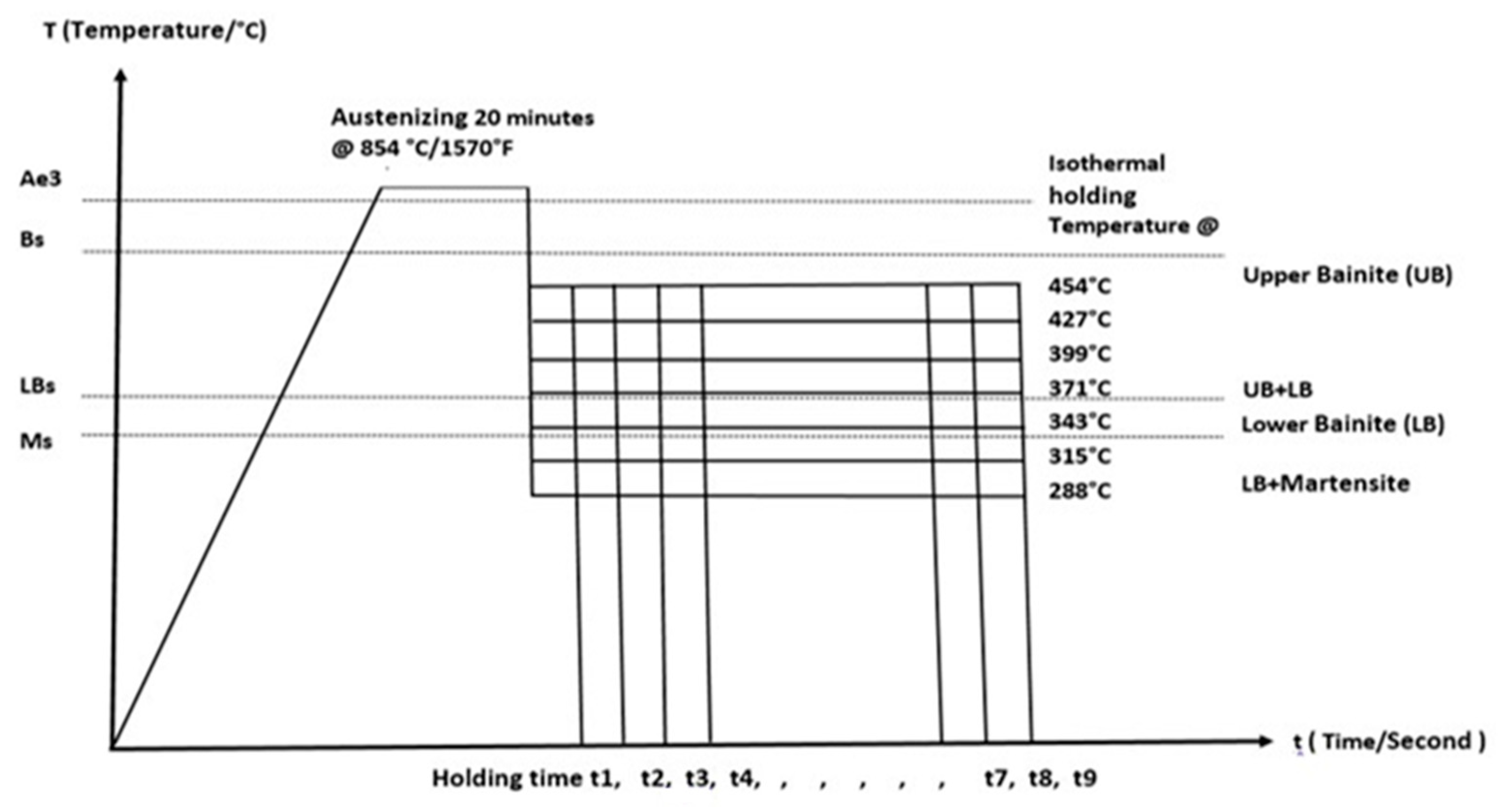
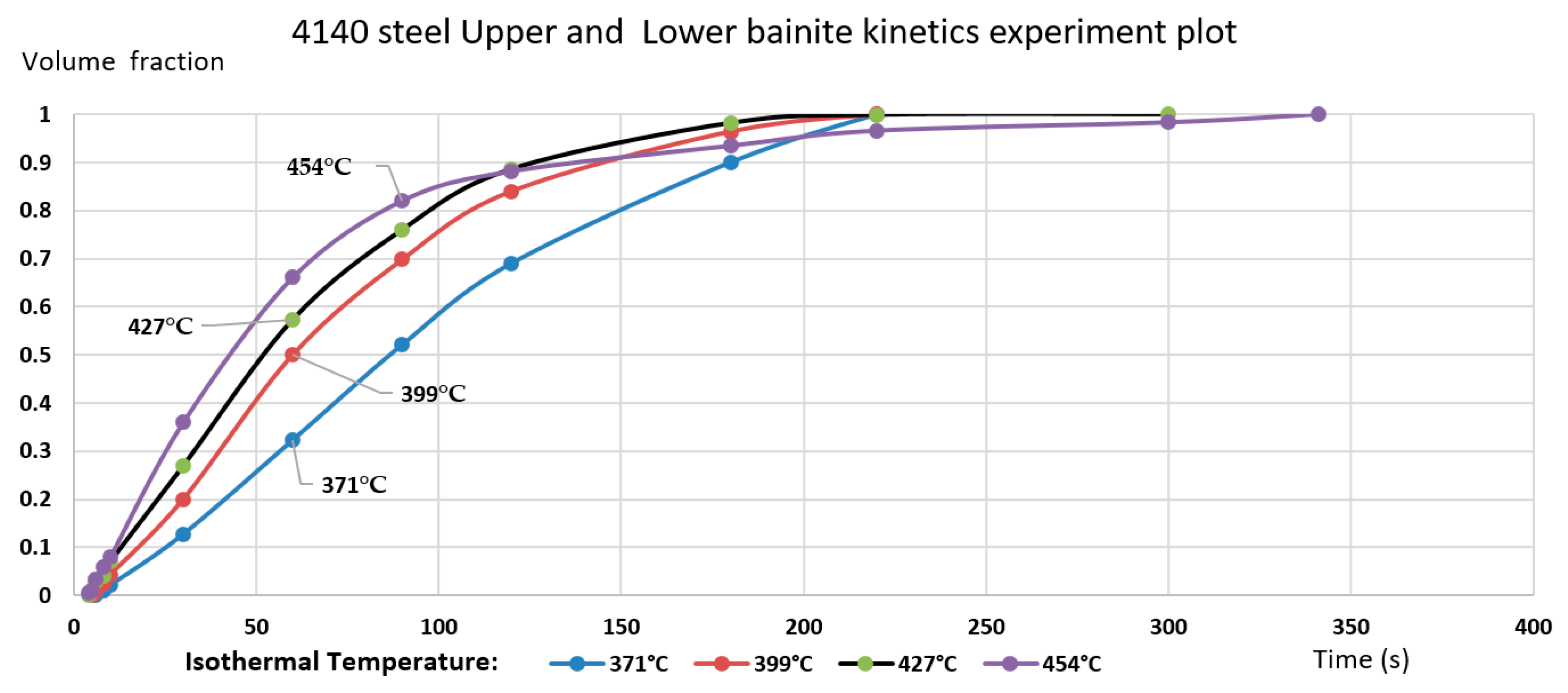
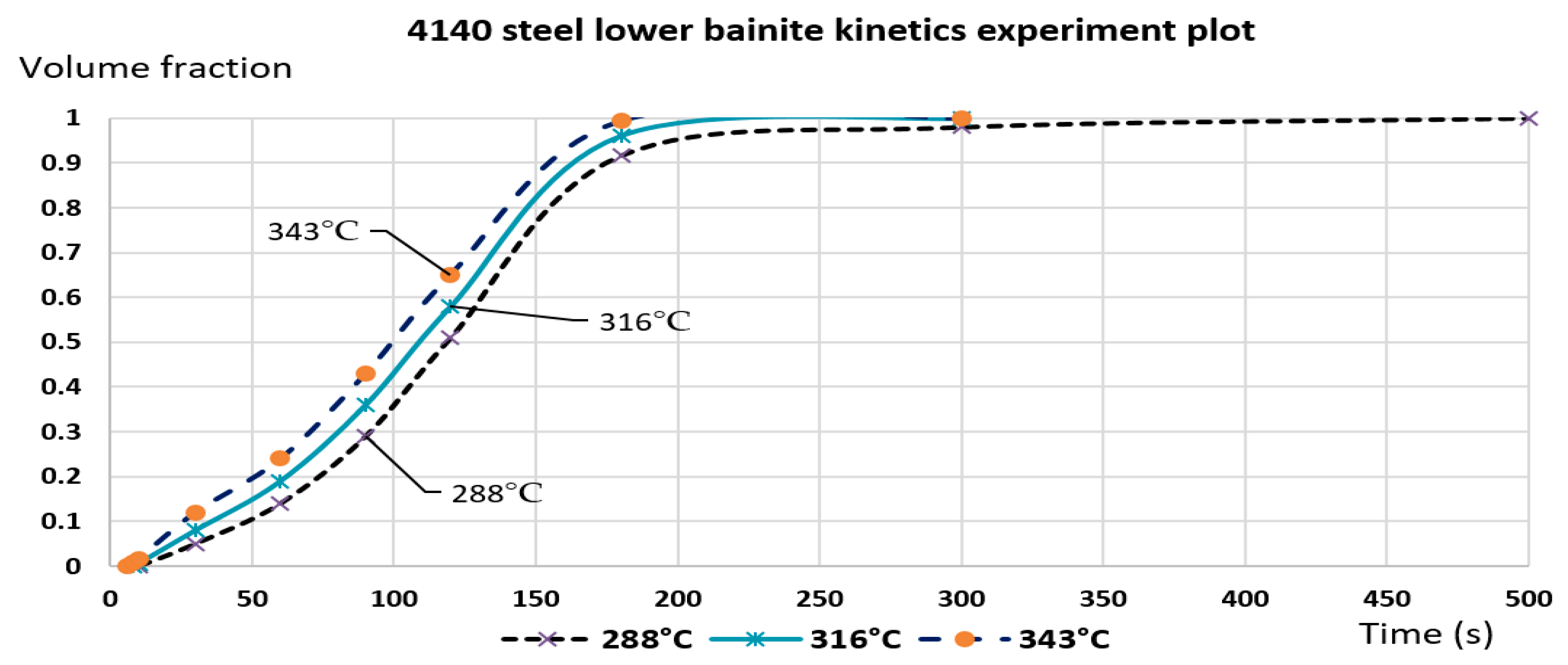
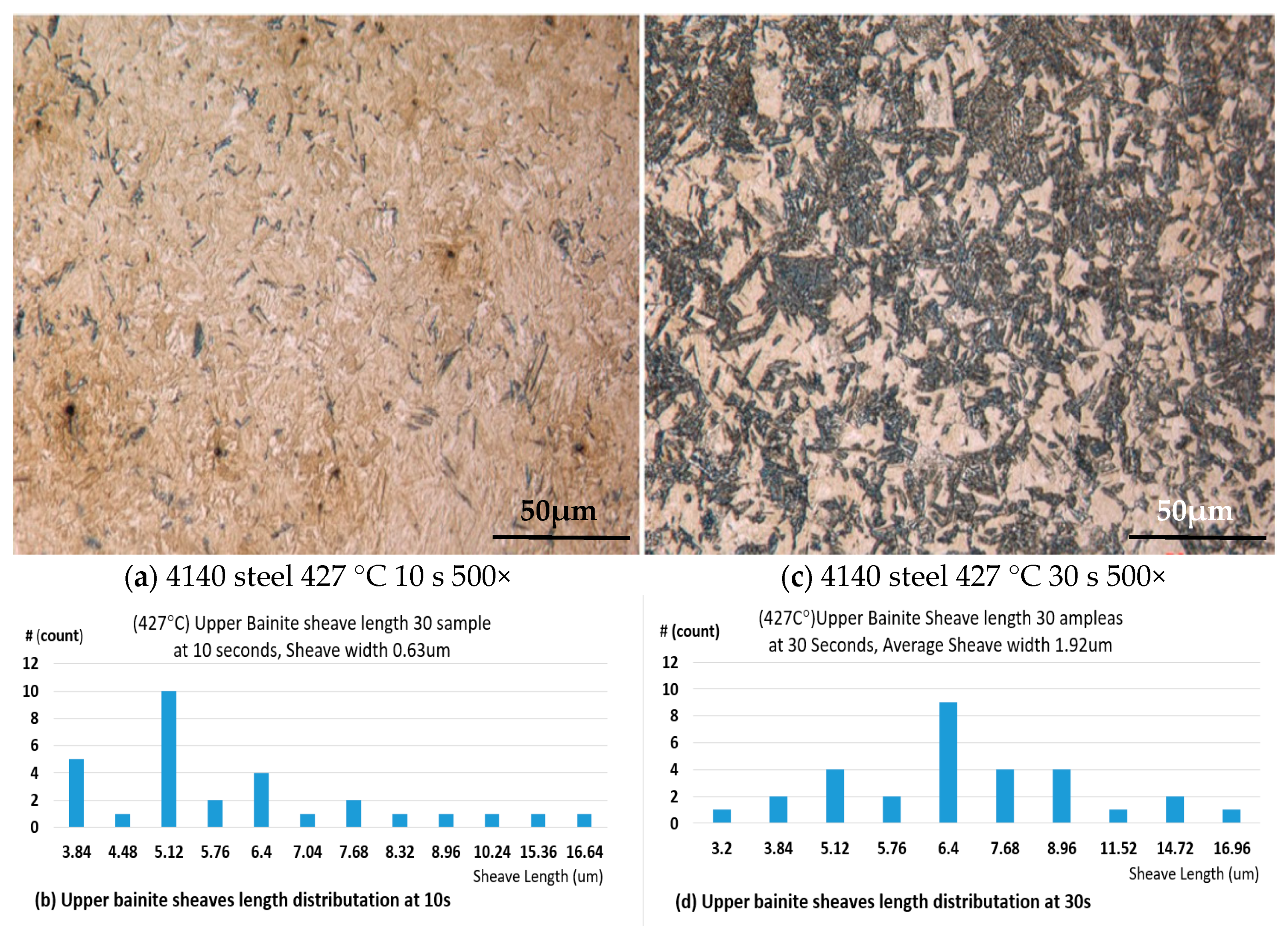
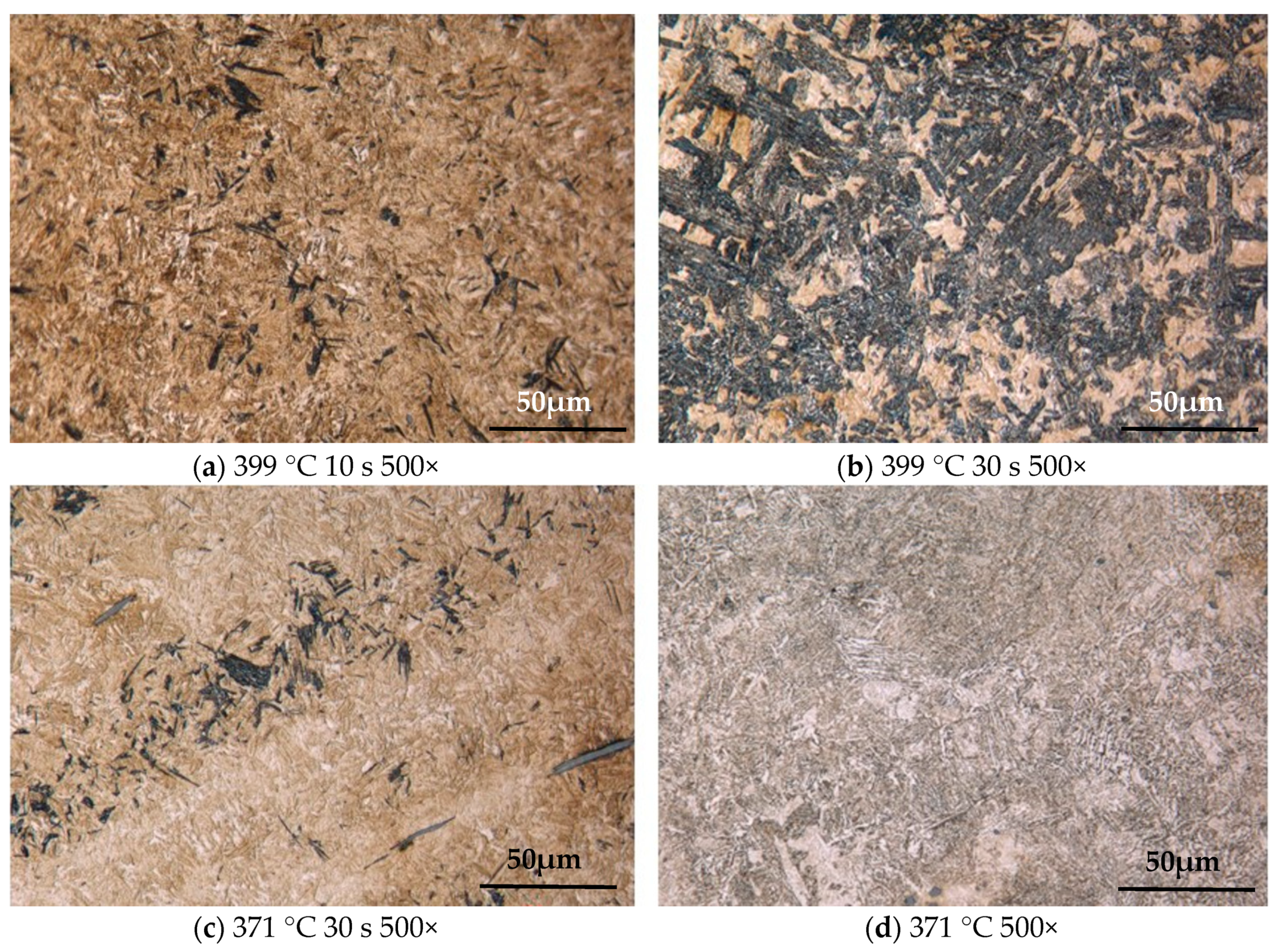
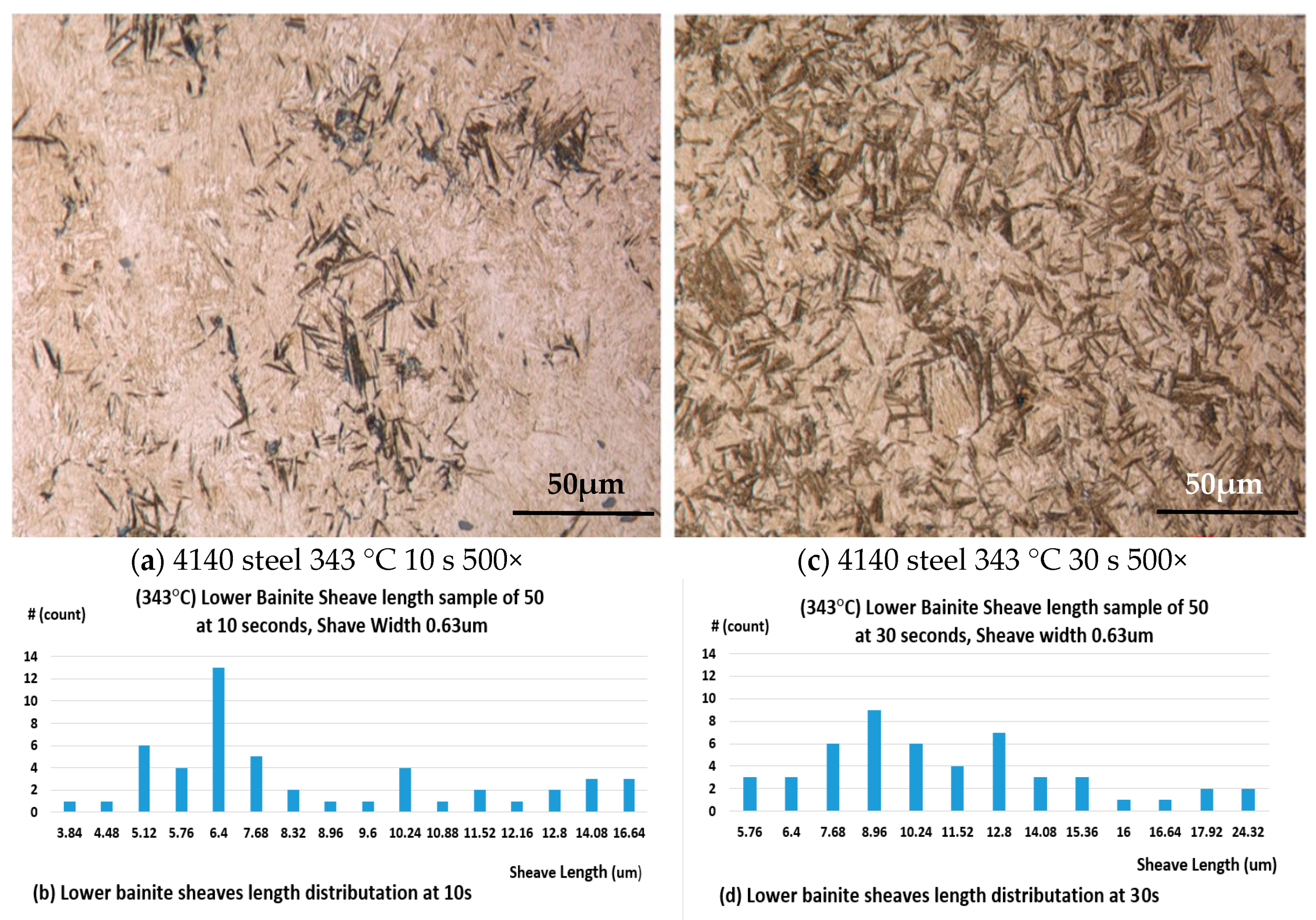
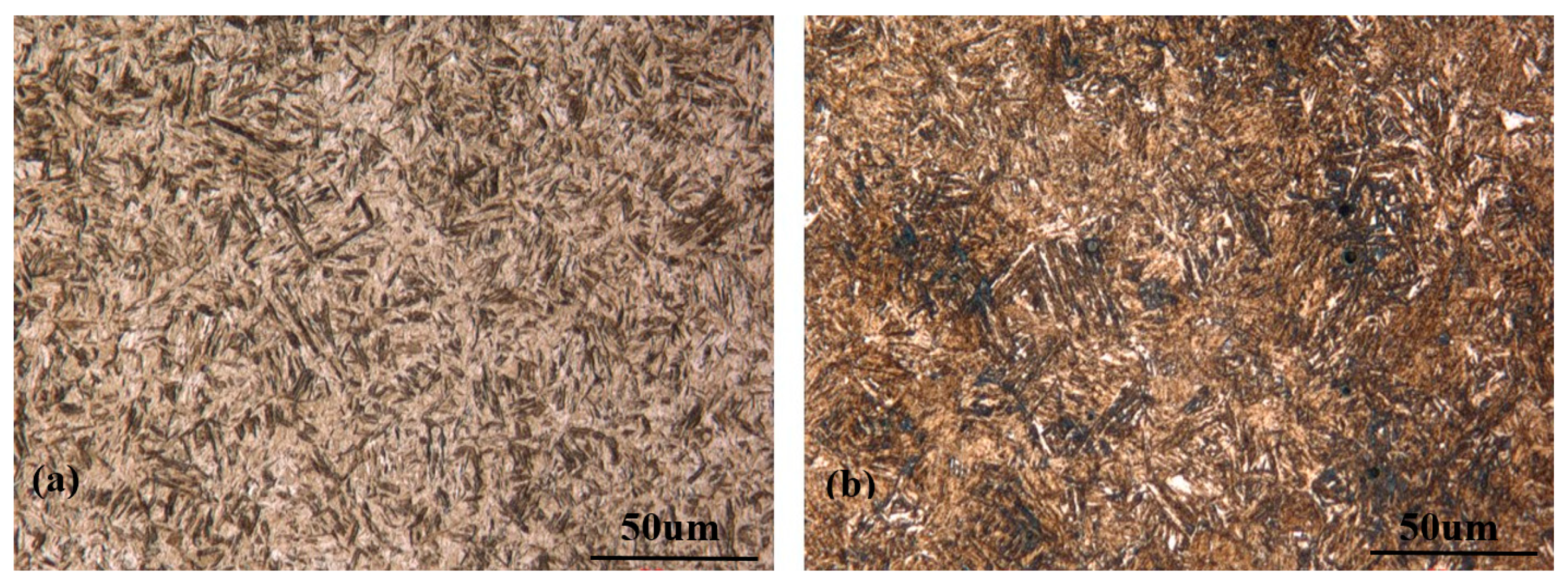
| Elements | Effects on Bs | Kinetics Function |
|---|---|---|
| C (Carbon) | As C content increases, Bs will decrease. When C content is high enough, Bs will not be affected. | Low Carbon, C diffusion easy, will generate carbide free bainite. High carbon content will decelerate transformation; Critical carbon content will determine when bainite transformation stops [30]. |
| B (Boron) | Lower Bs | Suppresses Transformation [31]. |
| Cr (Chromium) | Lower Bs | Hinders transformation, decreases driving force and the rate as content increases [32,33]. |
| Mo (Molybdenum) | Lower Bs | Retards/stabilities rate [33]. |
| Mn (Manganese) | Lower Bs | Lowers rate, may result in incomplete bainite reaction phenomenon [34,35]. |
| Co (Cobalt) | - | Accelerates the transformation [29] at low temperature [34]. |
| Al (Aluminum) | - | Accelerates the transformation due to its influence at low temperature [32]. |
| Si (Silicon) | - | Suppresses the formation of cementite, may result in incomplete bainite reaction [34]. |
| Ni (Nickel) | Lower Bs | Delays bainite reaction [33]. |
| Cu (Copper) | - | Copper precipitation with displacive mechanism in bainite reaction. |
| N (Nitrogen) | - | Enrichment in nitrogen tends to slow down bainite transformation [35]. |
| Element | Cr | Mn | C | Si | Mo | S | P | Fe |
|---|---|---|---|---|---|---|---|---|
| wt (%) | 0.80–1.10 | 0.75–1.0 | 0.38–0.43 | 0.15–0.30 | 0.15–0.25 | 0.040 | 0.035 | Balance |
| T (°C)/t(s) | * | 10 | 30 | 60 | 90 | 120 | 180 | 220 * | 300 | 600 |
|---|---|---|---|---|---|---|---|---|---|---|
| 454 | 59.8@3s | 57.3 | 49.2 | 35.5 | 35.5 | 33.8 | 32.2 | - | 30.8 | 30.3 ** |
| 427 | 60.1@4s | 58.0 | 52.7 | 39.4 | 39.4 | 36.0 | 33.4 | - | 32.9 ** | 32.3 |
| 399 | 60.3@5s | 59.2 | 55.2 | 42.5 | 42.5 | 38.9 | 35.7 | 34.8 | 34.6 | 33.8 |
| 371 | 60.4@6s | 59.9 | 57.3 | 47.8 | 47.8 | 43.7 | 38.8 | 36.2 | 35.9 | 35.1 |
| 343 | 60.5@6s | 60.2 | 58.1 | 52.4 | 52.4 | 48.7 | 42.8 | 41.9 | 41.8 | 41.3 |
| 316 | 60.6@8s | 60.5 | 59.4 | 55.0 | 55.0 | 51.7 | 45.6 | - | 45.0 ** | 44.6 |
| 288 | - | 60.7 * | - | 57.2 | 57.2 | 54.6 | 49.9 | - | 49.2 | 48.9 ** |
| Isothermal Temperature (°C) | n | log(K) | K | R2 |
|---|---|---|---|---|
| 454 | 1.0655 | −1.9654 | 0.01082929 | 0.9706 |
| 427 | 1.3339 | −2.4428 | 0.003607447 | 0.9989 |
| 399 | 1.5687 | −2.9536 | 0.001112756 | 0.9933 |
| 371 | 1.7370 | −3.4599 | 0.000346817 | 0.9804 |
| 343 | 1.8018 | −3.6445 | 0.000226725 | 0.9725 |
| 316 | 2.2056 | −4.5056 | 3.12176 × 10−5 | 0.9826 |
| 288 | 2.2357 | −4.8802 | 1.31765 × 10−5 | 0.9649 |
| Temp (°C) | T (K) | ln(1−0.5) | K | n | t50 | 1/t50 | 1/T | ln(t50) | ln(K) |
|---|---|---|---|---|---|---|---|---|---|
| 288 | 560.9 | 0.693147 | 0.000013 | 2.24 | 129 | 0.0078 | 0.001783 | 4.8589 | −11.2506 |
| 316 | 588.7 | 0.693147 | 0.000031 | 2.21 | 93 | 0.0108 | 0.001699 | 4.5317 | −10.3815 |
| 343 | 616.5 | 0.693147 | 0.000227 | 1.8 | 86 | 0.0116 | 0.001622 | 4.4578 | −8.39056 |
| 371 | 644.3 | 0.693147 | 0.000347 | 1.74 | 79 | 0.0127 | 0.001552 | 4.3676 | −7.96619 |
| 399 | 672.0 | 0.693147 | 0.001112 | 1.56 | 62 | 0.0162 | 0.001488 | 4.1250 | −6.8016 |
| 427 | 699.8 | 0.693147 | 0.003607 | 1.33 | 52 | 0.0192 | 0.001429 | 3.9537 | −5.62488 |
| 454 | 727.6 | 0.693147 | 0.010829 | 1.07 | 49 | 0.0205 | 0.001374 | 3.8869 | −4.52551 |
| Bainite Phase Matrix | Q (1/t50) (kJ/mol) | Q (K) (kJ/mol) |
|---|---|---|
| Overall Bainite (QB) | 19.3 | 136 |
| Upper Bainite (QUB) | 10.2 | 167 |
| Upper Bainite + Lower Bainite Q (UB + LB) | 31.5 | 151 |
| Lower Bainite (QLB) | 10.7 | 50 |
| Lower Bainite + Martensite Q (LB + M) | 32.3 | 86 |
© 2020 by the authors. Licensee MDPI, Basel, Switzerland. This article is an open access article distributed under the terms and conditions of the Creative Commons Attribution (CC BY) license (http://creativecommons.org/licenses/by/4.0/).
Share and Cite
Zhu, J.G.; Sun, X.; Barber, G.C.; Han, X.; Qin, H. Bainite Transformation-Kinetics-Microstructure Characterization of Austempered 4140 Steel. Metals 2020, 10, 236. https://doi.org/10.3390/met10020236
Zhu JG, Sun X, Barber GC, Han X, Qin H. Bainite Transformation-Kinetics-Microstructure Characterization of Austempered 4140 Steel. Metals. 2020; 10(2):236. https://doi.org/10.3390/met10020236
Chicago/Turabian StyleZhu, Jian G., Xichen Sun, Gary C. Barber, Xue Han, and Hao Qin. 2020. "Bainite Transformation-Kinetics-Microstructure Characterization of Austempered 4140 Steel" Metals 10, no. 2: 236. https://doi.org/10.3390/met10020236
APA StyleZhu, J. G., Sun, X., Barber, G. C., Han, X., & Qin, H. (2020). Bainite Transformation-Kinetics-Microstructure Characterization of Austempered 4140 Steel. Metals, 10(2), 236. https://doi.org/10.3390/met10020236






